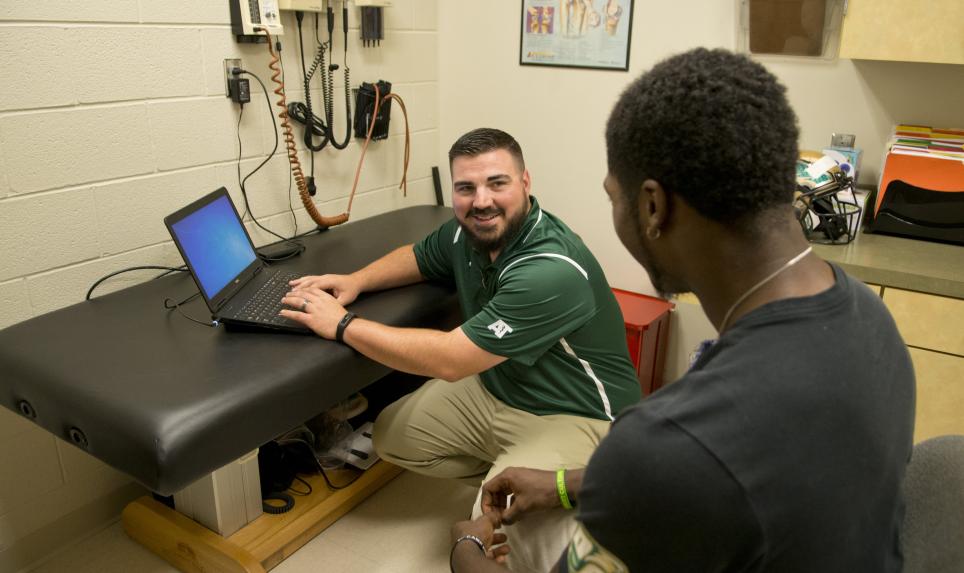One of the most common adjectives used to describe athletic trainers is invaluable. According to Merriam Webster, invaluable means “valuable beyond estimation” or “priceless.” Considering the services and care that athletic trainers provide, invaluable is an understatement in many cases. Saving a life, helping an athlete return to the sport that they love, preventing a catastrophic injury or providing a sense of safety and preparedness – these are all things that you cannot put a price on, and things that athletic trainers do on a daily basis.
While athletic trainers are certainly invaluable, perhaps more important in today’s data driven world is the fact that athletic trainers have measurable value as well. As health care professionals, athletic trainers provide detailed and robust data sets through documentation and record keeping. Athletic trainers track things like patient encounters, outcomes, clinical throughput, time loss, injuries and patient satisfaction. These numbers tell the story of just how many lives the athletic trainer reaches on a daily basis.
Additionally, athletic trainers provide indirect value to schools and communities. In schools that employ full time athletic trainers, students have lower injury rates and reduced absenteeism thanks to on campus rehabilitation. Parents spend less time away from work because of the onsite diagnosis and rehabilitation; parents also spend less time and money on unnecessary doctor visits because of the streamlined referral process that athletic trainers facilitate. The school experiences lower absenteeism, a potential for reduced insurance costs and reduced risk of litigation.
DOLLARS AND SENSE
Below are just a few facts related to the value of an athletic trainer in the school setting:
- Sport-related injury leads to approximately 20 million lost days of school1 and approximately $33 billion in health care costs each year.2
- 32% of parents had to take time off work from to bring their children to the hospital due to relatively minor injuries.3 By employing a full time athletic trainer who can provide medical care onsite, parents and kids spend less time away from work and school.
- Athletic trainers provide an average of 22 services for every ankle sprain. 4
- $1,233 is the average cost of an emergency room visit.5 Athletic trainers can help prevent unnecessary and costly trips to the emergency room.
- $14.7 million is the estimated annual cost savings in one state if every high school employed a full time AT.6
- 2,753,200 is the estimated value of 13,766 treatments provided by a school’s athletic trainer in one school year.7
This value is not confined to a school or sport setting. Employers, military branches and public service entities that employ athletic trainers reap similar benefits for their employees, service men and women, and public servants. Athletic trainers who work in hospitals and clinics improve patient satisfaction, increase downstream revenue and impact the bottom line.
Athletic trainers are health care professionals with a unique skill set that affects the full continuum of care. Athletic training is a relatively young profession and its’ value is in the infancy of being realized. As data continues to grow and demonstrate the full impact of the profession, more schools, organizations and employers will see athletic trainers as an investment instead of a line item, and shift from “we can’t afford to employ an athletic trainer” to “we can’t afford not to employ an athletic trainer.”
REFERENCES
- Janda DH. The Awakening of a Surgeon: A Family Guide to Preventing Sports Injuries and Deaths. Ann Arbor, MI: Institute for Preventative Sports Medicine; 2003.
- Summer sports top injury list. Orthop Today. 2022;22(16):13
- Abernethy L, MacAuley D. Impact of school sports injury. British Journal of Sports Medicine 2003;37:354-355. http://bjsm.bmj.com/content/37/4/354
- Kenneth C. Lam, Alison R. Snyder Valier, Barton E. Anderson, and Tamara C. Valovich McLeod (2016) Athletic Training Services During Daily Patient Encounters: A Report From the Athletic Training Practice-Based Research Network. Journal of Athletic Training: June 2016, Vol. 51, No. 6, pp. 435-441. https://doi.org/10.4085/1062-6050-51.8.03
- “How Much Will I Get Charged for This?” Patient Charges for Top Ten Diagnoses in the Emergency Department Nolan Caldwell, Tanja Srebotnjak, Tiffany Wang, Renee Hsia Published: February 27, 2013https://doi.org/10.1371/journal.pone.0055491 http://journals.plos.org/plosone/article?id=10.1371/journal.pone.0055491#s3
- Hambleton, MSA, AT, ATC, M., Smith, PhD, CAA, S., Eyers, EdD, AT, ATC, C., & Schneider, PhD, W. Cost Savings Analysis of a High School Athletic Trainer. International Athletic Administration, (Winter 2012), 8-11.
- McLeod, T. C. V., Bliven, K. C. H., Lam, K. C., Bay, C., Valier, A. R. S., & Parsons, J. T. (2013). The national sports safety in secondary schools benchmark (N4SB) study: Defining athletic training practice characteristics. Journal Athletic Training, 48(4), 483-492.
